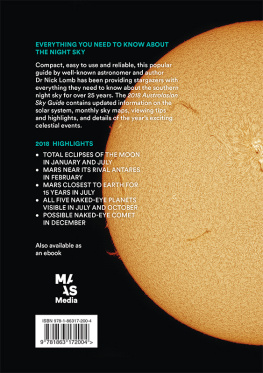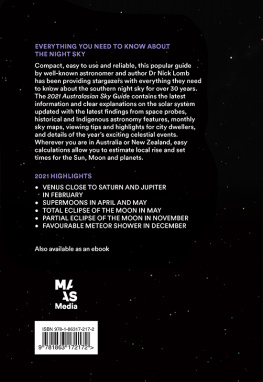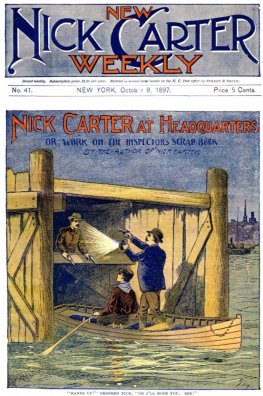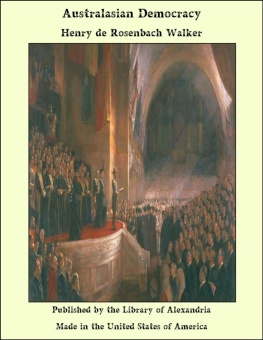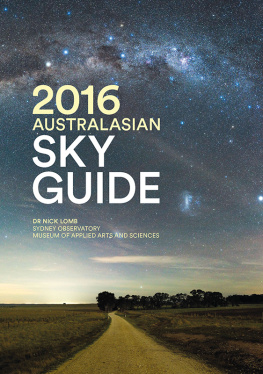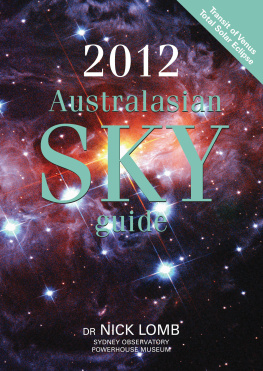Nick Lomb - 2018 Australasian sky guide
Here you can read online Nick Lomb - 2018 Australasian sky guide full text of the book (entire story) in english for free. Download pdf and epub, get meaning, cover and reviews about this ebook. year: 2017, genre: Children. Description of the work, (preface) as well as reviews are available. Best literature library LitArk.com created for fans of good reading and offers a wide selection of genres:
Romance novel
Science fiction
Adventure
Detective
Science
History
Home and family
Prose
Art
Politics
Computer
Non-fiction
Religion
Business
Children
Humor
Choose a favorite category and find really read worthwhile books. Enjoy immersion in the world of imagination, feel the emotions of the characters or learn something new for yourself, make an fascinating discovery.
- Book:2018 Australasian sky guide
- Author:
- Genre:
- Year:2017
- Rating:4 / 5
- Favourites:Add to favourites
- Your mark:
- 80
- 1
- 2
- 3
- 4
- 5
2018 Australasian sky guide: summary, description and annotation
We offer to read an annotation, description, summary or preface (depends on what the author of the book "2018 Australasian sky guide" wrote himself). If you haven't found the necessary information about the book — write in the comments, we will try to find it.
2018 Australasian sky guide — read online for free the complete book (whole text) full work
Below is the text of the book, divided by pages. System saving the place of the last page read, allows you to conveniently read the book "2018 Australasian sky guide" online for free, without having to search again every time where you left off. Put a bookmark, and you can go to the page where you finished reading at any time.
Font size:
Interval:
Bookmark:

Published annually since 1991 by Museum of Applied Arts and Sciences Media (formerly Powerhouse Publishing) Museum of Applied Arts and Sciences 500 Harris Street, Ultimo NSW 2007 maas.museum/store
PUBLICATION MANAGER Judith Matheson
EDITOR Cristina Briones
DESKTOP PUBLISHING Anne Slam
DIAGRAMS AND ILLUSTRATIONS Andy Chong/Picture This
COVER DESIGN i2i Design
PRINTING Ligare
ISBN 978 1 86317 200 4
ISSN 22011765
2017 Trustees of the Powerhouse Museum.
The Museum of Applied Arts and Sciences is an executive agency of the NSW Government.
This book is copyright. Apart from fair dealing for the purposes of study, research, criticism or review, or as otherwise permitted under the Copyright Act, no part of this publication may be reproduced by any process without written permission. Inquiries should be made to the publisher.
The author wishes to acknowledge the assistance and contributions made by staff at Sydney Observatory. The original monthly sky maps were prepared by Rod Somerville using the program Skymap.
All material is supplied in good faith and is believed to be correct. It is supplied on the condition that no warranty is given in relation thereto and no responsibility or liability for error or omission is, or will be, accepted.
At the time of publication, Daylight Saving Time ends in NSW, ACT, Victoria, South Australia, Tasmania and New Zealand at 3:00 am on Sunday 1 April 2018, when clocks should be turned back to 2:00 am. Daylight Saving Time begins again at 2:00 am on Sunday 30 September 2018 in New Zealand and at 2:00 am on Sunday 7 October 2018 in the relevant Australian states (). The information in this publication has been adjusted for summer time using the above times and dates.
The tide predictions for Sydney (Fort Denison) have been formatted by Museum of Applied Arts and Sciences Media from material supplied by the Bureau of Meteorology. The Bureau of Meteorology gives no warranty of any kind whether express, implied, statutory or otherwise in respect to the availability, accuracy, currency, completeness, quality or reliability of the information or that the information will be fit for any particular purpose or will not infringe any third party Intellectual Property rights. The Bureaus liability for any loss, damage, cost or expense resulting from use of, or reliance on, the information is entirely excluded.
CONTENTS
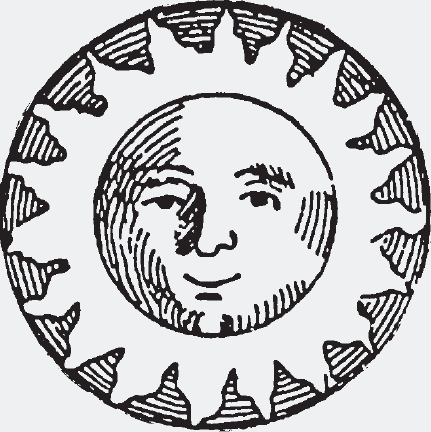
HOW TO USE THIS BOOK
Most of the astronomical information provided in this book is suitable for the whole of Australia and New Zealand. The descriptions of celestial events each month, such as the positions and movements of the planets, apply anywhere in the two countries. For local times of lunar eclipses and phases of the Moon in different time zones, just add or subtract the time difference; eg for New Zealand add two hours and for Western Australia subtract two or three (depending on daylight saving in eastern Australia).
Rise and set times
The rise and set times for the Sun, Moon and planets have been calculated for Sydney, but with suitable adjustments they can provide approximate times elsewhere. If you are close to the 34 latitude of Sydney you can adjust the times very simply for your location: take the difference between Sydneys longitude of 151.2 East and the longitude of your location (you can find this on most maps), multiply by 4 and add the result in minutes. The tide tables apply to Sydney only.
Capital cities
The following corrections are based on longitude differences and allow for daylight saving. For Melbourne, Adelaide, Perth and Auckland the possible errors with these adjustments will only be a few minutes. The errors will be somewhat larger for the other cities.

HIGHLIGHTS FOR 2018
7 JANUARY Mars near Jupiter. The red planet Mars passes near the giant planet Jupiter in the morning sky ().
31 JANUARY Total eclipse of the Moon. This is the first of two opportunities to see the Moon turn red this year ().
1213 FEBRUARY Mars near Antares. Antares, known as the rival of Mars, has a similar colour to the red planet, and so it is always spectacular when the two are close to each other ().
6 MAY Eta Aquariid meteor shower. The gibbous Moon obscures one of the years best meteor showers ().
1431 JULY Five naked-eye planets visible. When Mars joins the other four after dusk, all five planets visible to the unaided eye can be seen at once (). This happens again in October this year.
2731 JULY Opposition of Mars. This years opposition or close approach by Mars is particularly favourable ().
28 JULY Total eclipse of the Moon.(.)
823 OCTOBER Five naked-eye planets visible.(.)
16 OCTOBER Mercury near Venus. The two innermost planets are close together in the evening sky ().
910 NOVEMBER Mercury near Antares. The innermost planet passes close to reddish Antares, the brightest star in the constellation of Scorpius ().
1415 DECEMBER Geminid meteor shower. This is a good opportunity to see one of the best meteor showers of the year ().
16 DECEMBER Close approach by comet. Comet 46P/Wirtanen is closest to Earth on this date and is likely to be visible through binoculars and possibly with the unaided eye ().

Mars imaged during the less favourable opposition of 2016. Courtesy Anthony Wesley, Rubyvale, Qld
THIS YEARS EVENTS
31 JANUARY/1 FEBRUARY Total eclipse of the Moon. A total eclipse of the Moon is visible in its entirety throughout Australia and New Zealand on the night of Wednesday 31 January, extending into the early morning of Thursday 1 February. Total eclipses of the Moon are one of the most spectacular sights in nature, as during totality the Moon can take on a deep red colour. They are safe to watch with the naked eye. Photography is possible, preferably with a camera mounted on a tripod and a zoom lens.
The eclipse starts with the partial phase as the Moon moves into the dark shadow of the Earth, known as the umbra. After an hour or so the Moon is fully immersed in the umbra and is totally eclipsed. This is when it can take on a red colour, due to the Moon reflecting back the light of the red sunsets and sunrises around the rim of the Earth.
Circumstances in different Australian and New Zealand cities are given in the table below. All times are local.
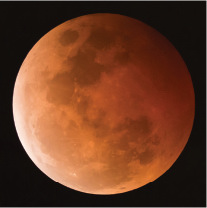
The totally eclipsed Moon of 8 October 2014 as seen from Sydney. Photo Geoff Wyatt, MAAS
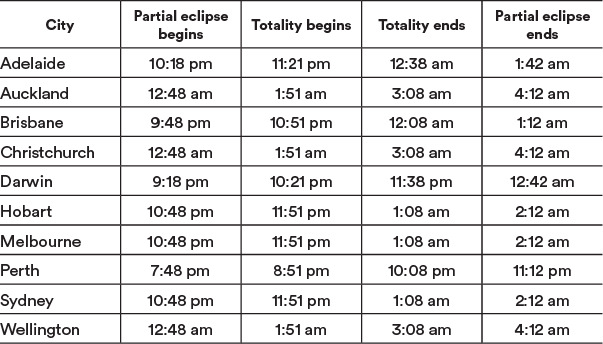
The next eclipse of the Moon visible from Australia and New Zealand is on the morning of Saturday 28 July () and will be total.
The Eta Aquariid Meteor Shower
Next pageFont size:
Interval:
Bookmark:
Similar books «2018 Australasian sky guide»
Look at similar books to 2018 Australasian sky guide. We have selected literature similar in name and meaning in the hope of providing readers with more options to find new, interesting, not yet read works.
Discussion, reviews of the book 2018 Australasian sky guide and just readers' own opinions. Leave your comments, write what you think about the work, its meaning or the main characters. Specify what exactly you liked and what you didn't like, and why you think so.

